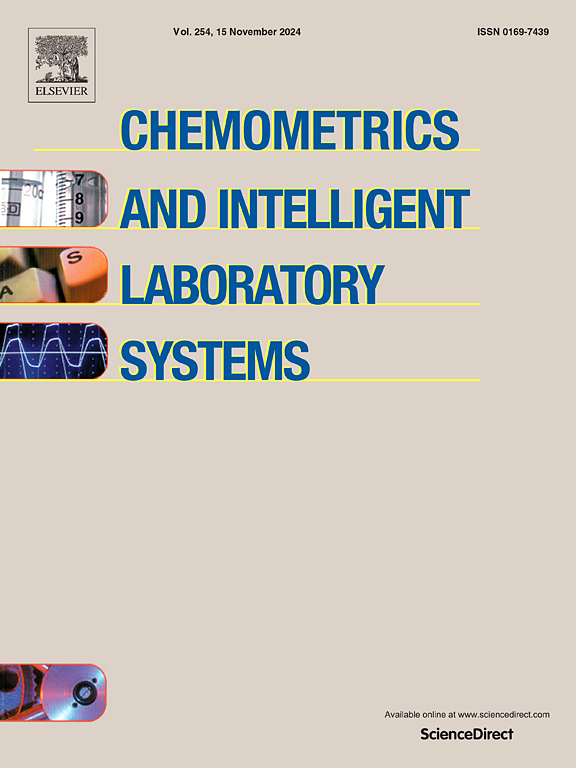GCNFG-DTA:Screening natural medicinal components of Cyperus esculentus targeting kinases with AIDD methods
IF 3.7
2区 化学
Q2 AUTOMATION & CONTROL SYSTEMS
Chemometrics and Intelligent Laboratory Systems
Pub Date : 2025-01-04
DOI:10.1016/j.chemolab.2025.105317
引用次数: 0
Abstract
Screening bioactive molecules from natural plant compounds is currently a common approach in the field of drug discovery. Cyperus esculentus, a multipurpose crop primarily used for food, is highly valued in certain countries or regions for its unique medicinal properties. Although there is a foundational understanding of its components and pharmacological effects, exploration of its effective targets, especially kinase targets, remains insufficient. Our study integrates Artificial Intelligence-Assisted Drug Design (AIDD) by utilizing the KIBA and BindingDB datasets to train the GCNFG-DTA deep learning model for predicting the kinase target affinity of 152 active compounds from Cyperus esculentus. By screening for high-affinity molecule-kinase target pairs and employing molecular docking and molecular dynamics simulations, the study successfully identified pairs of the most promising active molecule-target combinations. Our predicting results demonstrate that the GCN-GAT-FG model, with its excellent predictive ability (Achieving a low MSE of 0.131 and a high CI of 0.896), significantly accelerates the discovery process of bioactive molecules. Further molecular docking validated that 15 high-affinity molecule-kinase target pairs had docking energy scores below −5 kJ/mol. Among these, 14 pairs exhibited stable conformations during 100 ns molecular dynamics simulations. Notably, Cyanidin chloride, N-Feruloyltyramine, and Imbricatonol were identified as the most promising molecules, demonstrating the high conformational stability when targeting the MAP3K8, CLK4 and FGR kinase targets, respectively. These findings provide a scientific basis for further exploring the medicinal potential of Cyperus esculentus. Overall, the deep learning method used in our study offers new insights into the field of drug discovery related to natural compounds by rapidly and effectively predicting the specific medicinal value components of Cyperus esculentus.
GCNFG-DTA:用AIDD方法筛选沙柏靶向激酶的天然药物成分
从天然植物化合物中筛选生物活性分子是目前药物发现领域的一种常用方法。莎草是一种主要用于食品的多用途作物,因其独特的药用特性在某些国家或地区受到高度重视。虽然对其成分和药理作用有了基本的了解,但对其有效靶点,特别是激酶靶点的探索仍然不足。本研究结合人工智能辅助药物设计(AIDD),利用KIBA和BindingDB数据集训练GCNFG-DTA深度学习模型,用于预测香柏树152种活性化合物的激酶靶点亲和力。通过筛选高亲和度的分子激酶靶对,并采用分子对接和分子动力学模拟,成功鉴定出最有潜力的活性分子靶点组合对。我们的预测结果表明,GCN-GAT-FG模型具有出色的预测能力(实现了0.131的低MSE和0.896的高CI),显著加快了生物活性分子的发现过程。进一步的分子对接验证了15对高亲和分子激酶靶对的对接能量得分低于- 5 kJ/mol。其中14对在100 ns分子动力学模拟中表现出稳定的构象。值得注意的是,Cyanidin chloride、N-Feruloyltyramine和Imbricatonol被认为是最有希望的分子,它们分别在靶向MAP3K8、CLK4和FGR激酶靶点时表现出很高的构象稳定性。这些发现为进一步开发香柏草的药用潜力提供了科学依据。总之,我们研究中使用的深度学习方法通过快速有效地预测香柏树的特定药用价值成分,为天然化合物相关药物发现领域提供了新的见解。
本文章由计算机程序翻译,如有差异,请以英文原文为准。
求助全文
约1分钟内获得全文
求助全文
来源期刊
CiteScore
7.50
自引率
7.70%
发文量
169
审稿时长
3.4 months
期刊介绍:
Chemometrics and Intelligent Laboratory Systems publishes original research papers, short communications, reviews, tutorials and Original Software Publications reporting on development of novel statistical, mathematical, or computer techniques in Chemistry and related disciplines.
Chemometrics is the chemical discipline that uses mathematical and statistical methods to design or select optimal procedures and experiments, and to provide maximum chemical information by analysing chemical data.
The journal deals with the following topics:
1) Development of new statistical, mathematical and chemometrical methods for Chemistry and related fields (Environmental Chemistry, Biochemistry, Toxicology, System Biology, -Omics, etc.)
2) Novel applications of chemometrics to all branches of Chemistry and related fields (typical domains of interest are: process data analysis, experimental design, data mining, signal processing, supervised modelling, decision making, robust statistics, mixture analysis, multivariate calibration etc.) Routine applications of established chemometrical techniques will not be considered.
3) Development of new software that provides novel tools or truly advances the use of chemometrical methods.
4) Well characterized data sets to test performance for the new methods and software.
The journal complies with International Committee of Medical Journal Editors'' Uniform requirements for manuscripts.

 求助内容:
求助内容: 应助结果提醒方式:
应助结果提醒方式:


